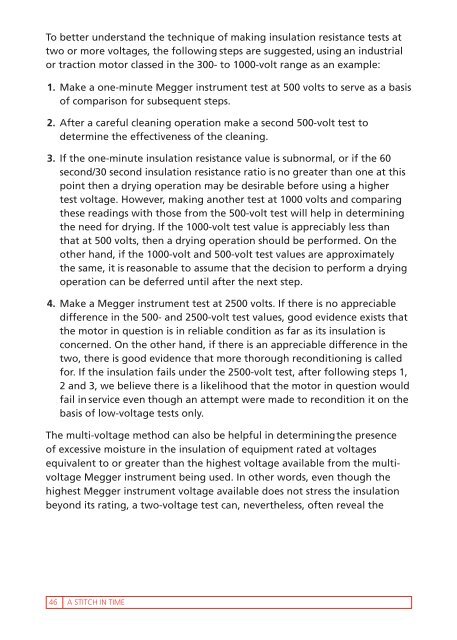“A Stitch in Time...”
Create successful ePaper yourself
Turn your PDF publications into a flip-book with our unique Google optimized e-Paper software.
To better understand the technique of mak<strong>in</strong>g <strong>in</strong>sulation resistance tests at<br />
two or more voltages, the follow<strong>in</strong>g steps are suggested, us<strong>in</strong>g an <strong>in</strong>dustrial<br />
or traction motor classed <strong>in</strong> the 300- to 1000-volt range as an example:<br />
1. Make a one-m<strong>in</strong>ute Megger <strong>in</strong>strument test at 500 volts to serve as a basis<br />
of comparison for subsequent steps.<br />
2. After a careful clean<strong>in</strong>g operation make a second 500-volt test to<br />
determ<strong>in</strong>e the effectiveness of the clean<strong>in</strong>g.<br />
3. If the one-m<strong>in</strong>ute <strong>in</strong>sulation resistance value is subnormal, or if the 60<br />
second/30 second <strong>in</strong>sulation resistance ratio is no greater than one at this<br />
po<strong>in</strong>t then a dry<strong>in</strong>g operation may be desirable before us<strong>in</strong>g a higher<br />
test voltage. However, mak<strong>in</strong>g another test at 1000 volts and compar<strong>in</strong>g<br />
these read<strong>in</strong>gs with those from the 500-volt test will help <strong>in</strong> determ<strong>in</strong><strong>in</strong>g<br />
the need for dry<strong>in</strong>g. If the 1000-volt test value is appreciably less than<br />
that at 500 volts, then a dry<strong>in</strong>g operation should be performed. On the<br />
other hand, if the 1000-volt and 500-volt test values are approximately<br />
the same, it is reasonable to assume that the decision to perform a dry<strong>in</strong>g<br />
operation can be deferred until after the next step.<br />
4. Make a Megger <strong>in</strong>strument test at 2500 volts. If there is no appreciable<br />
difference <strong>in</strong> the 500- and 2500-volt test values, good evidence exists that<br />
the motor <strong>in</strong> question is <strong>in</strong> reliable condition as far as its <strong>in</strong>sulation is<br />
concerned. On the other hand, if there is an appreciable difference <strong>in</strong> the<br />
two, there is good evidence that more thorough recondition<strong>in</strong>g is called<br />
for. If the <strong>in</strong>sulation fails under the 2500-volt test, after follow<strong>in</strong>g steps 1,<br />
2 and 3, we believe there is a likelihood that the motor <strong>in</strong> question would<br />
fail <strong>in</strong> service even though an attempt were made to recondition it on the<br />
basis of low-voltage tests only.<br />
The multi-voltage method can also be helpful <strong>in</strong> determ<strong>in</strong><strong>in</strong>g the presence<br />
of excessive moisture <strong>in</strong> the <strong>in</strong>sulation of equipment rated at voltages<br />
equivalent to or greater than the highest voltage available from the multivoltage<br />
Megger <strong>in</strong>strument be<strong>in</strong>g used. In other words, even though the<br />
highest Megger <strong>in</strong>strument voltage available does not stress the <strong>in</strong>sulation<br />
beyond its rat<strong>in</strong>g, a two-voltage test can, nevertheless, often reveal the<br />
46<br />
A STITCH IN TIME



